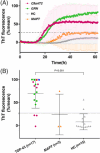Detection of TDP-43 seeding activity in the olfactory mucosa from patients with frontotemporal dementia
- PMID: 37908186
- PMCID: PMC10917048
- DOI: 10.1002/alz.13541
Detection of TDP-43 seeding activity in the olfactory mucosa from patients with frontotemporal dementia
Abstract
Introduction: We assessed TAR DNA-binding protein 43 (TDP-43) seeding activity and aggregates detection in olfactory mucosa of patients with frontotemporal lobar degeneration with TDP-43-immunoreactive pathology (FTLD-TDP) by TDP-43 seeding amplification assay (TDP43-SAA) and immunocytochemical analysis.
Methods: The TDP43-SAA was optimized using frontal cortex samples from 16 post mortem cases with FTLD-TDP, FTLD with tau inclusions, and controls. Subsequently, olfactory mucosa samples were collected from 17 patients with FTLD-TDP, 15 healthy controls, and three patients carrying MAPT variants.
Results: TDP43-SAA discriminated with 100% accuracy post mortem cases presenting or lacking TDP-43 neuropathology. TDP-43 seeding activity was detectable in the olfactory mucosa, and 82.4% of patients with FTLD-TDP tested positive, whereas 86.7% of controls tested negative (P < 0.001). Two out of three patients with MAPT mutations tested negative. In TDP43-SAA positive samples, cytoplasmatic deposits of phosphorylated TDP-43 in the olfactory neural cells were detected.
Discussion: TDP-43 aggregates can be detectable in olfactory mucosa, suggesting that TDP43-SAA might be useful for identifying and monitoring FTLD-TDP in living patients.
Keywords: TAR DNA-binding protein 43; frontotemporal dementia; frontotemporal lobar degeneration; olfactory mucosa; seeding; seeding amplification assays.
© 2023 The Authors. Alzheimer's & Dementia published by Wiley Periodicals LLC on behalf of Alzheimer's Association.
Conflict of interest statement
AB was partially supported by Fondazione Cariplo (grant n° 2021‐1516), and by the Fondation pour la Recherche sur Alzheimer. BB was partially supported by ADDF, unrelated to the present work; received personal fees from Alector, UCB, AviadiBio, Lilly, and Wave Life Sciences; and is listed as an inventor on a pending patent on the use of non‐invasive brain stimulation to increase cognitive functions in patients with neurodegenerative disorders. BG was partially supported by a R01‐AG075802 grant. MB, EB, CS, LS, AC, SC, EB, FG, MI, AS, CF, MF, KLN, LC, HJG, MPC, MP, AP, SM, GL, and GZ report no disclosures. This work was supported by project funding from Target ALS Foundation. Author disclosures are available in the supporting information.
Figures




References
-
- Cairns NJ, Bigio EH, Mackenzie IRA, et al. Neuropathologic diagnostic and nosologic criteria for frontotemporal lobar degeneration: consensus of the Consortium for Frontotemporal Lobar Degeneration. Acta Neuropathol. 2007;114(1):5‐22. http://link.springer.com/10.1007/s00401‐007‐0237‐2 - DOI - PMC - PubMed
-
- Gorno‐Tempini ML, Hillis AE, Weintraub S, et al. Classification of primary progressive aphasia and its variants. Neurology. 2011;76(11):1006‐1014. http://eutils.ncbi.nlm.nih.gov/entrez/eutils/elink.fcgi?dbfrom=pubmed&id... - PMC - PubMed

